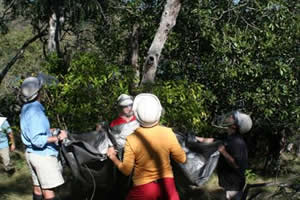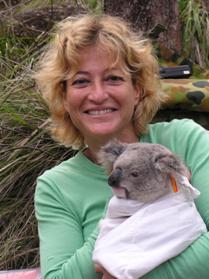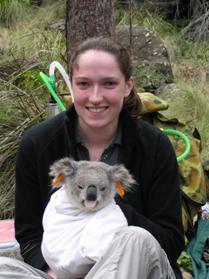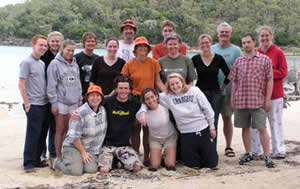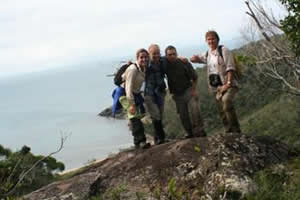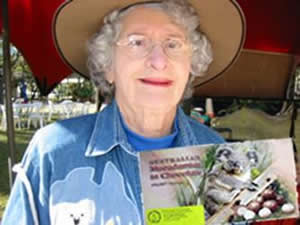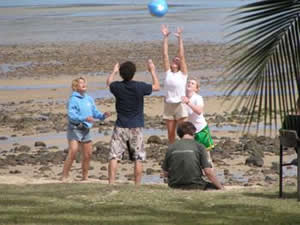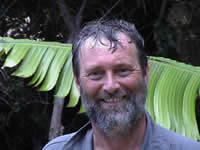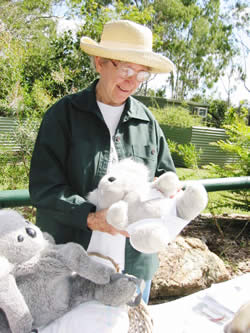 |
|||||||||||
Reports from Sean Fitzgibbon - Alistair Melzer - Carmen - Dawn - Shirley - Steering committee - St Bees - From Gail Sausage Sizzle - Arts in the Park - PhD Candidate Scholarship |
|||||||||||
| SPRING
EDITION NEWSLETTER 2005 |
|||||||||||
|
The July trip ran between 20th July and 1st August. The team was lead by Bill Ellis and Gail Tucker, with the assistance of our field mentor Sean Fitzgibbon, intern Kristin Stillman and post-graduate student Delma Clifton.
The remaining team members were 12 Earthwatch volunteers, with one from Madrid, Germany and the UK and the remaining 9 from all corners of the US. We tracked koalas all over the island (some of our young males have taken up residence in the northern bays, quite a hike from base camp) that added 160 tracking records to our database. In all, 9 koalas were caught - 2 clean skins, two for a routine collar change and 5 were fitted with new collars to measure their movement and temperature. These new collars recording movement and temperature are part of Delma Clifton’s PhD project. Details of her project will be in future newsletters.
A couple of interesting things that happened during the trip included:
The next trip will take place between the 14th and 26th October, which will see Alistair Melzer back on the island with our next team of eager volunteers. |
|
||||||||||
|
|||||||||||
|
CQ Koala Volunteers seek the conservation of the koala and other tree living mammals in Central Queensland by +Supporting research into koalas, other arboreal mammals and their habitat through (a) providing volunteer support to research projects, and (b) assisting in the raising of funds for research and the volunteer teams; + Developing public awareness of the needs of koalas, tree living mammals and their habitat requirements generally; + Fostering community support for koalas and tree living mammals generally; + Encouraging and assisting with the development of habitat rehabilitation projects where necessary through the region; +Supporting the rehabilitation and release of sick, injured or displaced koalas and tree living mammals. The Central Queensland Koala Volunteers are not about stopping development. They seek to encourage planned development, which allows for the co-existence of koalas and other tree living mammals with human activity. Funds are used to buy equipment for the researchers, to fund volunteer field teams and provide limited support for animal carers. Donations may also be made to the Koala Research Centre of Central Queensland and are tax deductible. Office
Bearers Direct correspondence
to: |
Report
from recent Steering Committee Meetings 30 August, 2005 Nick has once again updated the web site and you will find interesting anecdotes of the doings of the Volunteers and many pictures in the Gallery. Gail reported on the latest trip to St Bees, which was quite wild - see her report above The fund raising endeavours at the Heritage Village, Koala Day at Botanic Gardens and Multicultural Fair were all discussed The Chocolate Drive has been most successful. Reports & Carmen The librarian at the North Rockhampton Library praised the display there from 4 to 16 July. Thanks to Gail and Dawn. Forth coming fund raising events: NOTE
FROM GAIL
|
||||||||||
From the Treasurer’s DeskJune, July and August have been successful months with over $450.00 being raised at Heritage Village Market Day, Koala Day, Multicultural Fair and final sales of calendars and post cards. Carmen’s Orphan Koalas continue to be a good seller. We sold Aussie plants – Cat’s Whiskers – nurtured by Doreen. Somehow, Gail managed to sell some 2005 calendars to the Earthwatch participants on St Bees. The Koala Chocolate Drive has been a great success.
Koala Chocolate Drive
Nick Quigley’s initiative has been a winner and approximately
Nick and I coordinated this fundraiser with strong support from members, sales at public display days and CQU staff. The icing on the cake came from sales to outside contacts.
P.S. If you have not paid your 2005 subscription and wish to continue your support, payment by the end of October would be appreciated. |
|||||||||||
. |
Yes, we hope to run our Koala Chocolate Drive in June, July and August, 2006. It would be appreciated if members or people receiving the newsletter could suggest outside groups/employers who may be sellers in 2006. Please contact me on my email Fund raising is not an easy task and, as treasurer, I certainly appreciate the efforts of members and supporters. |
||||||||||
CQKV Brochure
Attached to the Newsletter are two great brochurs, which have been designed by Nick Quigley. We are very grateful to Nick for his generosity with his computer skills. The brochures are to be used as publicity for our cause and, hopefully, to increase our membership base. Please pass the brochures on to likely prospects and let us know if you would like more. The brochure is now available on our web site:
Nick also produced stickers attached to each box of Chocolates sold and the nametags for volunteers. He has also been revamping our web page: He has also been helping with the newsletter – he designed the new heading. (Ed) |
Top |
||||||||||
|
Research Services of CQU advise that they have re-advertised this scholarship, so hopefully, there will be a successful candidate for 2006.
Congratulations to Gail and Paul who are expecting their first baby in January. No more tree climbing for Gail for some time! Hoping you have a happy pregnancy, Gail.
Shirley Hopkins |
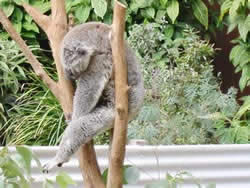 |
||||||||||
Volunteers wanted! We’re proposing an extensive study of Queensland koalas and their habitat and believe that it provides an opportunity for the Central Queensland Koala Volunteers to undertake expeditions to a variety of natural areas across Queensland and gather information that is important for koala conservation and for future national park management.
It is proposed to establish a number of permanent monitoring sites at locations of secure tenure across the range of the koala in Queensland. The aims are: 1. to examine koala habitats in different biogeographical regions and contrasting environmental conditions to follow the fate of koalas and 2. to attempt to understand how these populations and their habitat may be changing over time. To be successful this project will require an ongoing commitment by community volunteers and research scientists to visit the sites periodically but systematically.
Each site visit will require mounting a field expedition, establishing a camp on or near the study area, collecting data and samples where necessary and subsequently undertaking laboratory studies, data analyses and reporting. We will be seeking the support of the Central Queensland Koala Volunteers to assist in the provision of field assistance and in the funding of this project. Please contact us if you are interested in joining in this venture.
If you have not been on a koala expedition before these will give you the opportunity to learn about koalas and their ecology as well as skills in bushcraft and field survey techniques. The trips are also lots of fun for those who enjoy the Australian bush. Where possible we are intending to make the expeditions accessible to mature people of all ages.
We are currently planning the first of the expeditions to locate potential study sites. Contact us if you are interested. A timetable of expeditions, site specific physical limitations, equipment needs, organisational details and potential costs will be placed on our web site as each expedition is planned and each site is established.
ContextKoalas are widespread but patchily distributed across Queensland. The research approach to date has generally involved intensive radio tracking studies at a few locations (Brisbane EPA, UQ, AKF, Stradbroke Island UQ, Springsure EPA, UQ, CQU, Clermont UQ, St Bees Island UCQ, UQ). These studies provide detailed descriptions of koala habitat use and population dynamics and have provided insight into some potential general principals in koala population dynamics and habitat utilisation. There has been one bioregional study in the Mulga lands (UQ). This gives a model for estimating population density at a bioregional scale but requires replication. A study in central north-west Queensland (JCU) investigated koala habitat use using trace data in a very sparse koala population. We propose an extensive investigation of koala populations and their habitat in Queensland. It is intended to produce comparative date on koala habitat structure and relative population densities across Queensland. Subsequent studies will collect data on genetic variation and morphological variation among the target populations.
ApproachSurveys will be undertaken in selected protected land across Queensland to identify koala populations for study. The selected sites will attempt to sample the extent of koala distribution and the range of major bioregions where koalas occur in Queensland. Some possible sites are: Dry Tropical Central North-west Queensland Moorinya NP Subhumid sub-tropical Western Central Queensland Mt Zamia NP Dry sub-tropical Central South Queensland Idalia NP Humid tropical Off shore central Queensland South Cumberland NP (St Bees Is., Rabbit-Newry NP) Subhumid tropical Eastern Central Queensland Goodedulla NP Mt Archer NP Humid sub-tropical South-east Queensland To be determined
Methods(1) Site establishment Study areas will be located at locations where koalas occur within the conservation tenure. (2) Relative population density In three areas standard, systematic surveys will provide a relative measure of population density. A team of people will systematically search all trees, shrubs and lianes in a defined area. Koalas will be counted. Gender and breeding status will be noted if possible. Care will be taken to avoid recounting of the same sighting. Surveys are undertaken within a single daylight period to avoid problems associated with koalas moving overnight, (3) Tree use The day surveys will provide data on daytime tree species use, tree size and ecosystem utilisation. Night spotlight surveys will provide similar data on nocturnal tree and ecosystem use. (4) Diet Foliage will be collected from trees used by koalas at night. Reference preparations from leaf cuticles will be prepared. Fresh koala faecal pellets will be collected. Slides of cuticle fragments will be prepared. Cell patterns in the faecal pellet cuticle fragments will be compared to the reference cuticles to determine the tree species consumed. (5) Morphology and age at death Skeletal material encountered will be collected and analysed. Data on skull morphology will be used to investigate morphological differences among regional populations. Toothwear patterns will be studied to reveal information on longevity among the populations and the utility of the method in contrasting bioregions. (6) Describing koala habitats At each site the structure and composition of koala habitats will be described using plotless sampling techniques at randomly identified points across the areas searched earlier. (7) Sharing the habitat Data on the occurrence of other arboreal mammal (possums, gliders) will be collected at the same time as the koala survey. The habitat descriptions will include data collection on the nature and occurrence of tree hollows and dead trees within koala habitat.
Resourcing(1) Site establishment It is estimated that three days per site and one to three people will be required to establish each site. (2) Data collection A further six to 12 days are required to collect the field data at each site with three to 15 people. (3) Data entry and analyses Data entry will take two days per site for a research worker or trained volunteer. (4) Diet analyses Three working weeks per site for an experienced technician to prepare the reference slides, prepare the faecal pellet fragments and search the slides Top
|
|||||||||||
| A stall
of merchandise including shirts, cups, keyrings, orphan koalas, plants and
chocolates was held on Market Day at the Heritage Village
on Sunday, 10 July. Orphan koalas sold well. The Cat’s Whiskers plants,
donated by Shirley and potted and nurtured to point of sale by Doreen also
sold out. A total of $61 was raised by the volunteers. The sale of chocolates is not included in that total. Shirley concentrated her efforts on selling chocolates with a total of 79 boxes being sold by the end of the day. Helpers on the day were Shirley, Doreen, Nick, Carmen and Dawn. Arts in the Park – 9 October. The Volunteers hold a stall at Arts in the Park each year under the big Banyan trees in the Botanic Gardens. We will be needing helpers on the day to set up and man the stall on that Sunday. If you can give an hour of your time somewhere on that day, please let Dawn know on 4928 1798.Thank you. |
|||||||||||
Report
from Carmen
Coming
up in October 9th is Arts in the Park where we have a stall.
We will have to have an‘orphan’ drive to replenish our supplies. If your
op. shop has small cuddly koalas in good condition we would grateful for
them. Contact me on 4927 6117. |
|||||||||||
Report from Sean Fitzgibbon It was a vision splendid that drew me to St Bees Island as a CQK volunteer on the 2005 mid-year Earthwatch trip; images of koalas perched high and content, overlooking gentle green hills, wide blue oceans, and calm sandy bays, all bathed in glorious sunshine. Where do I sign! But there was trouble in paradise upon arrival. We were greeted by driving rain, rough seas, and Home Bay emptied of water. The sour weather had forced the barge driver to pull the pin on our original travel arrangements, so Bill and Gail swung into action with Plan B: numerous light aircraft flights from Mackay to Keswick Island, with the tinny then used to ferry goods and the dozen Earthwatch volunteers over to St Bees. It was quite a mission but we got there in the end. On a positive note, the success of our final crossing of the channel between Keswick and Bees renewed my belief in an interventionist God. I have seen the light! Actually, the difficulties of our arrival brought us all together as a team before we even knew each others’ names, and set the tone for what was to be an AWESOME fortnight chasing teds. By the end of the first week the rain had given way to that glorious sunshine I felt we were owed. Despite the initial poor weather the crew of volunteers, mostly American but with a hint of German, Spanish, and English, had risen to the occasion and were daily tracking koalas with gusto. Each evening we shared our tales of the day’s efforts, which usually involved at least two people ploughing head first into spider webs and a special mention for Ronnie. Not blessed with sure-footedness, Ronnie was our ever amusing American mum who regularly fell flat on her ‘hiney’ while trudging up and down the hills of Bees. Eye-sight was not a strong point for Ronnie either, and knots in tree branches were often proudly declared as koalas, while real koalas just 20 m distant took 5 minutes to point out. But what she lacked in finesse she more than compensated for with warmth and a wonderful sense of humor. In fact, there wasn’t a volunteer among us that didn’t bring something special to the table (mustard biscuits in my case). It truly was a pleasure to be with such a great bunch of people. By the second week we had located a wayward ted named Utopia who had moved a couple of kilometers towards the north of the island since being radio-collared on a previous Earthwatch trip. Each morning a small team would set off with their tracking gear to cover the hilly terrain between home base and this renegade koala. As our poet volunteer Bob later penned, a trip to ‘Utopia’ was sort of the opposite really. But while Team Utopia were battling the undergrowth, those closer to home were regularly struggling to locate Lollipop and Cameron in the canopy of rainforest gullies. Sure, the hills are a bit steep, but everyone seemed to be having a fantastic time. Squeezed among tracking duties were occasional koala catches, when the opportunities presented themselves. All our attempts were successful, ending with koalas in bags with a minimum of fuss. Seeing the smiles on the volunteers’ faces when up close and personal with a koala was just magic. Being an Aussie, it’s nice to be reminded just how amazing our unique wildlife is. When koala commitments were all taken care of we found time to hit
the beach at low tide to introduce the foreigners to one of Australia’s
great past-times - cricket. Wasn’t it a winner! And when the bowlers
worked out that sending down something the batter could actually hit,
the field came to life. |
|||||||||||
| Top | |||||||||||

